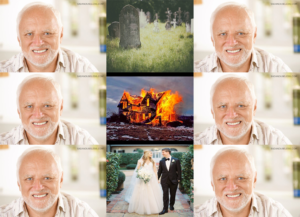All posts by Kacper B
Filters
Hollywood Prompt Cards
Hollywood Powerpoint
Dunkirk Task
Sound is an important element in Christopher Nolan’s Dunkirk (2017), the term narrative device means conveying the story forwards or trying to tell us something important. An example of this is through the character of Mr. Dawson, the captain of one of the civilian ships requisitioned to help the stranded soldiers. Mr. Dawson recognizes the engines of the planes that fly over his ship. This use of diegetic sound helps convey messages about the character of Mr. Dawson that he has experience with military aircraft and it’s confirmed after the oil scene when he tells the pilot that his son was in the air force.
Another use of sound as a narrative device is in the Final Dog Fight scene, where the German dive bomber is about to drop a bomb on where Commander Bolton is standing. Hans Zimmer’s use of a shepherd tone, where an illusion is created that the sound constantly rises, creates a sense of tension in the non-diegetic sound, the score. The use of this makes us feel Commander Bolton’s sense of impending doom which never arrives because he is saved by the pilot. This helps build up the plot.
The use of sounds and musical score and soundtrack is often used to fill in on the minimal amount of dialogue in the film, sources vary on the actual amount but there are only around 2 pages of dialogue in the actual film, the minimalistic use of dialogue in the film reflects the mood and feeling of the soldiers feeling of helplessness. It almost reflects the silent era where you had to use more visual effects to tell the progress the narrative and Nolan has even admitted to this.
Film Tableau

Mise-En-Scene Bladerunner Repost
Bladerunner – Mise-En-Scene Scene
The scene that I have decided to choose for my analysis of mise-en-scene is the ‘Tears in the Rain’ scene. I have chosen this scene because I think that it shows most of the elements of Mise-En-Scene.
Firstly, the use of set design in the scene is important, the scene is the rooftop of a building and this is reflected in the movie, the scene doesn’t have any props that the actors interact with and the lack of anything in close range causes the viewer to fully focus on the actors and pay more attention to what they are saying.
The use of space in the scene is also important, Deckard and Roy are very close to each other and their proximity reflects their relationship as how with Roy’s dying moments they seem to grow a bond.
One of the more worked on aspects of Mise-En-Scene in the film is the use of lighting, the scene is usually dark but occasionally has flashes of light that usually highlight the features of the character that the camera is currently at. The use of the low light reflects the sad nature of the scene, the flashes of light are often used to show the details on the characters faces.
The use of hair and makeup are also important in the scene because it shows the character as being close to death. Roy’s hair being white shows that he’s near death, and how his hair is disheveled shows how tired the character is and that he’s ready to die. Deckard’s hair shows fatigue and exhaustion and fear because he isn’t sure of Roy’s motives and from the fight and pursuit scene from before.
Cinematography Activity 3
An example of a canted shot or a dutch angle is from Thor (2011, Branaguh). I think that this makes the viewer feel uneasy with how the camera isn’t even.

An example of a low angle shot is from Pulp Fiction (1994, Quentin Tarantino)

Cinematography Activity 2
An example of a medium long shot is in the film The Dark Knight (2008, Christopher Nolan). This had the effect that it presented the severity of the explosion.
An example of a close up shot is The Shining (1980, Stanley Kubrick) I think that the effect was that the viewer was that they see the antagonists face and the emotions that they are portraying.

An example of an extreme close up is in Revenge Of The Sith (2005, George Lucas) I think that the viewer would notice the details of General Grievous

Cinematography Activity 1
A use of intra-deigetic perspective is in American Sniper (2014, Clint Eastwood) where the camera perspective is from the main protagonist looking through the sniper scope.
A use of deigetic perspective is the panoramic shot used in Lord of The Rings (2001, Peter Jackson) In the panoramic shots used to show the landscape.
A use of extra-deigetic perspective is how a character looks straight at the camera to try and involve the veiwer, an example is ‘Wolf of Wall Street’ (2013,
Cinematography Starter
Cinematography is the art of using the camera in film and photography,
A Cinematographer is someone who is decided what sort of camera angles to use and the use of lighting
